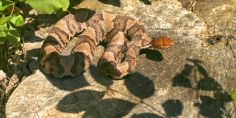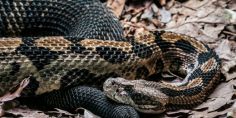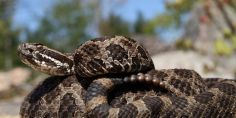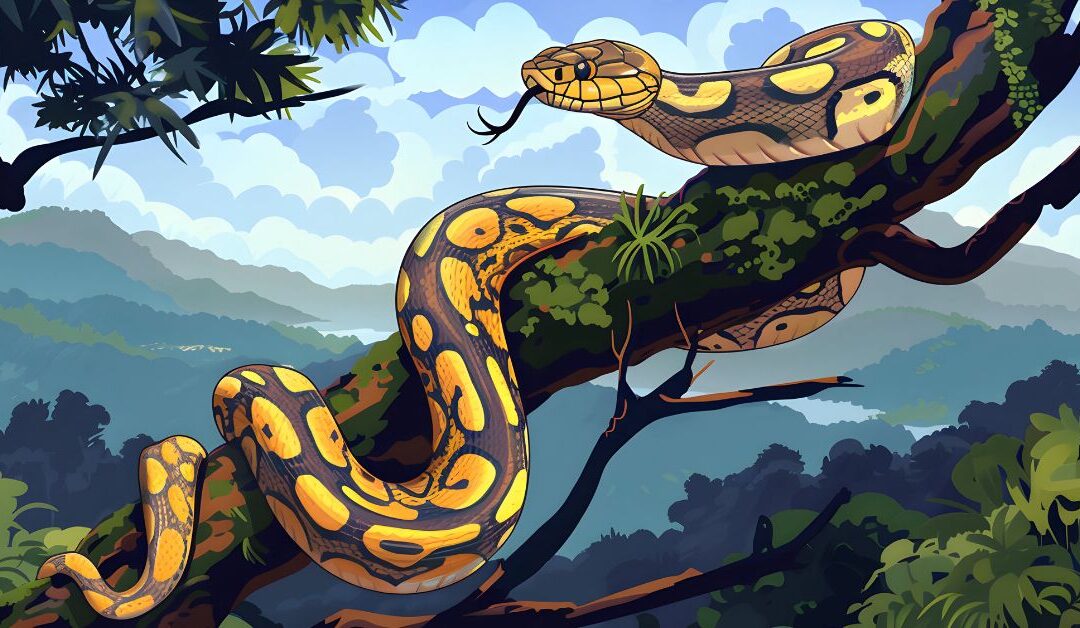I. Introduction
Indiana is home to a variety of wildlife, including several species of venomous snakes and deadly snakes. These venomous snakes are an important part of the ecosystem, and understanding these species of snakes is crucial for both residents and visitors to the state. This blog will provide a detailed overview of the poisonous snakes in Indiana, their habitats, behaviors, and safety tips for avoiding dangerous encounters. Awareness of these dangerous snakes is essential for ensuring safety and fostering respect for their role in nature. By learning about the different species of snakes, individuals can better appreciate and safely coexist with these fascinating creatures.
II. Types of Poisonous Snakes in Indiana
Copperhead (Agkistrodon contortrix)
- Description and Identifying Features:
- Hourglass-shaped crossbands
- Coppery-tan coloration
- Triangular head with vertical pupils
- Habitat and Distribution:
- Deciduous forests, rocky hillsides, and near water sources
- Commonly found in southern Indiana
- Behavior and Venom Potency:
- Generally not aggressive, but will bite if threatened
- Hemotoxic venom causing severe pain and tissue damage, rarely fatal

Timber Rattlesnake (Sistrurus catenatus)
- Description and Identifying Features:
- Dark crossbands on a lighter background, often yellow or brown
- Distinct rattle on the tail
- Heavy-bodied with a broad head
- Habitat and Distribution:
- Deciduous forests and rugged terrain
- Primarily found in southern Indiana
- Behavior and Venom Potency:
- Relatively docile, rattles as a warning before striking
- Potent venom that requires prompt medical attention

Eastern Massasauga Rattlesnake (Crotalus horridus)
- Description and Identifying Features:
- Gray or light brown body with dark blotches along the back
- Segmented rattle, smaller and more slender than the Timber Rattlesnake
- Keeled scales giving a rough texture
- Habitat and Distribution:
- Wetlands, marshes, and grasslands
- Found mainly in northern Indiana
- Behavior and Venom Potency:
- Shy and reclusive, often hides rather than confronts
- Venomous bite can cause significant medical issues but is rarely lethal to humans

Common Misconceptions
Water Moccasins (Cottonmouths): Water moccasins, often referred to as cottonmouths, are frequently misunderstood, with many believing they are native to Indiana. This misconception might stem from their presence in neighboring regions, leading to confusion about their actual habitat range. However, it’s important to clarify that water moccasins are not found in Indiana.
These venomous snakes are more commonly found in the southeastern United States, thriving in warm, humid environments such as swamps, marshes, and slow-moving streams. Their preference for aquatic habitats suits the climates of southern states, but Indiana’s cooler and less humid conditions are not conducive to their natural range.
The confusion is further compounded by the presence of non-venomous water snakes in Indiana, which bear a resemblance to water moccasins. These lookalikes can cause alarm among residents and visitors who mistake them for the more dangerous cottonmouths. Similarly, although not venomous, the Northern Ring-Necked Snake is often mistaken for more dangerous species due to its habitat overlap. Understanding these distinctions is essential for fostering a well-informed appreciation of Indiana’s snake population and reducing unwarranted fear.
By addressing this misconception, we can promote a safer and more knowledgeable interaction with Indiana’s wildlife, ensuring both human safety and the protection of the state’s diverse ecosystem.
III. Habitats and Distribution of Poisonous Snakes in Indiana
General Overview:
Indiana is home to a variety of snake habitats that cater to the unique preferences of its native poisonous snakes:
-
Copperheads are typically found in rocky and forested areas, often near water sources. They thrive in the southern parts of Indiana, especially in hilly and rocky regions where their camouflage can be most effective.
-
Timber Rattlesnakes prefer the rugged, hilly terrains with dense forest cover. These snakes are more commonly located in the south-central part of Indiana, residing in remote and heavily wooded areas that offer ample protection and hunting grounds.
-
Eastern Massasaugas are associated with wetlands and grassy environments. Predominantly found in northern Indiana, these snakes are most at home in wetland habitats, which offer ideal conditions for their survival.
Specific Locations:
- Copperheads: Concentrated in Southern Indiana’s hilly and rocky terrains.
- Timber Rattlesnakes: Found in the secluded, forested areas of South-central Indiana.
- Eastern Massasaugas: Inhabit Northern Indiana, particularly thriving in wetland habitats.
Seasonal Impact:
The activity of these snakes is significantly influenced by seasonal changes. During the warmer months, from spring to early fall, snakes are most active, taking advantage of the favorable weather for hunting and breeding. As temperatures drop in the winter, snakes enter a period of hibernation, substantially reducing sightings until the warmth returns.
In discussions about Indiana’s water habitats, the Midland Water Snake deserves mention. Unlike the poisonous snakes, it is non-venomous and commonly found in wetland areas throughout the state. This snake’s presence in water habitats often leads to it being mistaken for more dangerous species, but it plays a key role in controlling fish and amphibian populations, contributing to the ecological balance of Indiana’s wetlands.
IV. Behaviors of Poisonous Snakes in Indiana
Typical Behaviors:
- Generally shy and avoids human contact
- More active during mating seasons or in warmer weather
- Rattlesnakes use their rattle as a warning signal
- Pit vipers, including species like the Copperhead and Rattlesnake, use their heat-sensing abilities to detect prey.
Signs of Aggression vs. Defensive Actions:
- Aggression: Striking, coiling tightly, and hissing
- Defence: Rattling, retreating, and using camouflage to blend with the surroundings
- Pit vipers often rely on their camouflage for defence.
Common Myths and Misconceptions:
- Myth: Snakes chase humans.
- Fact: Snakes typically flee from humans unless cornered or threatened.
- Myth: All snakes are dangerous.
- Fact: Many snakes are non-venomous and beneficial to the ecosystem.
V. Personal Stories or Anecdotes
- Real-life Encounter:
- A hiker in southern Indiana encountered a Timber Rattlesnake on a trail.
- The snake’s warning rattle allowed the hiker to retreat safely without incident.
- This highlights the importance of staying alert and respecting wildlife.
VI. Snake Identification Tips
- Distinguishing Features:
- Copperhead: Hourglass-shaped bands, coppery colour
- Timber Rattlesnake: Dark crossbands, distinct rattle
- Eastern Massasauga: Dark blotches, segmented rattle
- Elliptical pupils: are another key feature to identify venomous snakes like pit vipers.
- Visual Aids:
- Use photos and diagrams to identify key features
- Pay attention to the shape of the head and patterns on the body
- Importance of Identification:
- Prevents unnecessary panic or dangerous handling
- Ensures proper medical treatment if bitten
VII. Myths and Facts about Poisonous Snakes in Indiana
-
VII. Myths and Facts about Poisonous Snakes in Indiana
Common Myths:
Understanding the truth about snakes can help dispel unnecessary fears and misconceptions. Here are some common myths about poisonous snakes, particularly rattlesnakes, and the facts that set the record straight:
-
Myth: Rattlesnakes always rattle before striking.
Fact: While rattlesnakes are known for their distinctive rattlesnakes, they do not always give a warning before striking. Depending on the situation, some may strike silently to defend themselves without alerting their presence. -
Myth: Snakes are aggressive by nature.
Fact: Most snakes, including rattlesnakes, are not inherently aggressive. They typically avoid human interaction and only strike when they feel threatened or cornered. Understanding snake behaviour can help reduce unnecessary fear and encourage respectful coexistence.
Interesting Facts:
Snakes play a vital role in the ecosystem and have surprising benefits for humans as well:
- Snake venom is used in medical research and treatments. Snake venom has been instrumental in developing life-saving medications, including treatments for hypertension, blood clots, and even cancer. This highlights the importance of preserving snake populations for ongoing scientific advancements.
Among the non-venomous snakes in Indiana, the Blue Racer often finds itself mistaken for a more dangerous species. Its long, slender body and quick movements can cause alarm, leading to false assumptions about its threat level. However, the Blue Racer is harmless to humans and contributes to controlling pest populations. Recognizing harmless snakes like the Blue Racer is crucial for reducing unnecessary fear and promoting coexistence. Educating the public about such species can help shift perceptions and foster appreciation for all of Indiana’s snake species.
-
VIII. Safety Tips for Encountering Poisonous Snakes in Indiana
Encountering a snake in the wild can be a startling experience, but knowing how to handle these situations safely is key to avoiding harm. Here are some tips to ensure safe interactions with Indiana’s snake population:
Identify from a Safe Distance:
When you spot a snake, it’s crucial to keep a safe distance. Use binoculars or your camera’s zoom feature to observe the snake without getting too close. This method is especially useful when identifying snakes near water bodies, where species like the non-venomous water snake can often be confused with their venomous counterparts.
Steps to Take During an Encounter:
If you find yourself in close proximity to a snake, stay calm and avoid making sudden movements. Slowly back away, allowing the snake ample space to retreat. Most snakes will not chase or attack if they do not feel threatened.
First Aid for Snake Bites:
In the unfortunate event of a snake bite, remain calm and keep the bitten area immobilized to slow the spread of venom. Seek immediate medical assistance for proper treatment. Avoid old-fashioned remedies such as attempting to suck out the venom or applying a tourniquet, as these can cause more harm than good.
Preventive Measures:
Prevention is the best way to stay safe. When hiking in areas known for snake activity, wear boots and long pants to protect against bites. Stick to well-trodden paths and avoid walking through tall grass or underbrush where snakes may be hiding.
By following these guidelines, you can enjoy Indiana’s natural beauty while respecting the local wildlife. Remember, most snakes play an important role in the ecosystem and would rather avoid human contact.
IX. Legal Aspects and Regulations Regarding Poisonous Snakes in Indiana
- Handling and Protection Laws:
- It is illegal to harm or capture protected snake species in Indiana.
- Penalties:
- Violations can result in fines or other penalties.
- Role of Agencies:
- Local wildlife agencies enforce laws and promote conservation efforts to protect these snakes.
X. Conservation and the Role of Poisonous Snakes in Indiana’s Ecosystem
- Ecological Importance:
- Poisonous snakes help control rodent populations, which can prevent the spread of diseases.
- Conservation Status:
- Varies by species, with efforts focused on habitat preservation and public education.
- Conservation Efforts:
- Organizations work to preserve natural habitats and educate the public on the importance of snakes.
XI. Expert Interviews on Poisonous Snakes in Indiana
- Insights from Herpetologists:
- Experts discuss the ecological role of snakes and their behavior.
- Emphasize the importance of snakes in maintaining ecological balance.
- Local Wildlife Experts:
- Provide advice on safe coexistence and highlight ongoing conservation efforts.
XIV. Community Involvement
- Local Events and Workshops:
- Information on snake safety and conservation events.
- Opportunities for the community to learn and get involved.
- Wildlife Organizations:
- Details on how readers can support local efforts and participate in conservation programs.
XV. FAQs on Poisonous Snakes in Indiana
- Common Questions:
- Q: What should you do if you see a snake in your yard?
- A: Observe from a distance and allow it to move away on its own.
- Q: How do you identify a poisonous snake?
- A: Look for specific features such as head shape, eye pupils, and body patterns.
- Q: What are the emergency steps if bitten by a snake?
- A: Remain calm, keep the bitten area immobilized, and seek immediate medical attention.
Recap:
Understanding and respecting poisonous snakes in Indiana is crucial for safety and conservation.
Final Thoughts:
Encourage readers to coexist safely with these vital creatures and contribute to their preservation.
Additional Resources on Poisonous Snakes in Indiana
Local Wildlife Organizations:
Contact information and links to organizations dedicated to snake conservation.
Snake Identification Guides:
Recommended reading and resources for further information on identifying poisonous snakes.
Poison Control and Wildlife Services:
Contact information for emergencies and reporting snake sightings.
By understanding and respecting the poisonous snakes in Indiana, we can coexist safely and help preserve the natural balance of our ecosystems.

